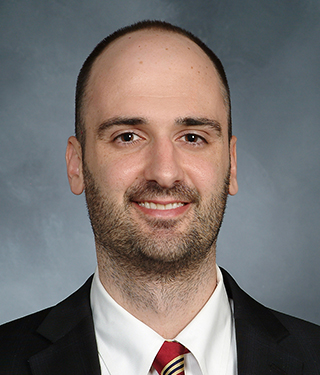Narcan is Now Available Over-the-Counter: What to Know
An expert in addiction psychiatry at NewYork-Presbyterian/Weill Cornell Medical Center shares what to know about Narcan, a naloxone product that reverses opioid overdoses.

Beginning in September, Narcan – a nasal spray that contains naloxone, which is a medication that reverses opioid overdoses – will be available for purchase without a prescription.
The life-saving medication will be sold in pharmacies, grocery stores, and online. Emergent BioSolutions, its manufacturer, suggested a retail price of $44.99.
In March, the Food and Drug Administration (FDA) authorized Narcan for over-the-counter, nonprescription use, paving the way for more access to the medication.
Dr. Jonathan Avery, an expert in addiction psychiatry at NewYork-Presbyterian/Weill Cornell Medical Center, says that greater availability of the life-saving medication comes at an important time. “The drug overdose crisis continues in the United States,” he says. In the 12-month period ending in March 2023, there were 105,224 lives lost, estimates from the Centers for Disease Control and Prevention showed. “It’s not getting any better.”

Dr. Jonathan Avery
Prior to the FDA’s authorization, people either had to go through training on how to use Narcan to obtain it, or they needed a prescription from their doctor to get it from the pharmacy.
“There were barriers with the way it was given out, and we wanted it to be more accessible to people, without those hurdles,” says Dr. Avery, who emphasizes that the nasal spray is safe and easy to use. “Now, Narcan will be available for purchase in places like local grocery stores. The FDA approval in March was important because it will hopefully increase access and help save lives.”
Dr. Avery spoke with Health Matters on what to know about Narcan and how to use it to save a life.
What does Narcan contain? How does it work?
Narcan is a nasal spray version of naloxone — the medicine that reverses opioid overdoses. A Narcan package will come with two nasal spray devices with four milligrams of naloxone in each.
If someone has overdosed on opioids and is administered Narcan, naloxone will attach to the opioid receptors in the person’s brain, reversing the overdose and restoring their breathing. Naloxone only works if someone has opioids in their system, such as fentanyl, heroin, oxycodone, hydrocodone, codeine, and morphine.
What are the signs that someone is experiencing an overdose?
Some signs include being unresponsive or unconscious, breathing slower, having small pupils and bluish lips, and turning blue or gray.
The first thing to do is check for responsiveness. Shout their name, shake them and rub their sternum or chest area. If there is no response, follow these steps:
- Call 911.
Before administering Narcan, we encourage you to call 911 right off the bat. Narcan is short acting, lasting 30 to 90 minutes. If you rescue someone, Narcan will reverse the overdose and restore their breathing. But when it wears off, the person could go back into an opioid overdose. - Lay them on their back and administer the Narcan.
Hold the nasal spray with your thumb on the bottom of the plunger and two fingers on either side of the nozzle. Place the tip of the nozzle in either of the person’s nostrils until your fingers touch the bottom of their nose. Press the plunger firmly to release the dose. - Move the person onto their side.
This can prevent them from choking or aspirating if there is any vomiting. At this stage, they should be breathing normally, reorienting and should be able to sit up. Observe them until the emergency care team arrives. - If needed, use the second device.
If the person does not wake up or respond within two to three minutes after the first spray, use the second device to administer another dose in the person’s other nostril.
Who should carry Narcan? Why is it important to do so?
Anyone at an increased risk for opioid overdose, or family and friends of someone who is. People cannot administer Narcan to themselves, so it is important to let others know that you have Narcan and where it is so that they can administer it.
But everyone should carry it. The Centers for Disease Control and Prevention states that in nearly 40% of overdose deaths, someone else was present. Having Narcan readily available and knowing how to use it can help save lives.
What else should people keep in mind?
Having Narcan be more accessible could help encourage conversation about substance use. Narcan saves lives, but we do not consider it a treatment for opioid use disorder. Our hope is that people will seek help through treatments, medications, and therapies. We want access to Narcan not only to be an invitation to save people’s lives but also to be an invitation to talk about addiction and to seek out care if someone is struggling, as with any other medical condition.
Jonathan Avery, M.D. is the vice chair for addiction psychiatry, the Stephen P. Tobin and Dr. Arnold M. Cooper Associate Professor in consultation liaison psychiatry, and the program director for the Addiction Psychiatry Fellowship.
Dr. Avery has published works on a wide variety of topics in addiction psychiatry, including papers on subjects ranging from clinician attitudes toward patients to how to use buprenorphine. He is the founder of the Program for Substance Use and Stigma of Addiction at NewYork-Presbyterian/Weill Cornell Medical Center, and his research on stigma is supported by several national grants and awards. He was on the editorial board for DSM-5 Clinical Cases and is the editor/author of 10 books, including Co-occurring Mental Illness and Substance Use Disorders: A Guide to Diagnosis and Treatment and The Stigma of Addiction: An Essential Guide. He has won numerous awards for his clinical and academic work, including the American Board of Psychiatry and Neurology Faculty Innovation in Education Award and the Outstanding Faculty Member Award from the New York County Psychiatric Society.

